Hike #1543; 4/20/23 Morristown and Loantaka Loop with Justin Gurbisz, Kenny Zaruni, and Gregory Andre (with Scout and Saga)
This next one would be a big loop hike I'd done one year prior, and attempted to do the year before that.
The idea for this hike evolved out of trying to find stroller-able hikes to do with my son and Jillane soon after he was born.
I knew I wanted to indoctrinate him into the hiking world as early as I could, but I never would have expected that it would have started when he was just 44 days old, or that his mother would allow for him to be taken out so early after he was born.
Admittedly, even I was worried about the effect it might have on him that early on, but it ended up being just fine, and he grew accustomed to being in the stroller from the very early age, so it was all the better.
When I first planned the hike not two months after Ev was born, I planned to do the loop with Jillane, but she cut out just above Acorn Hall. She told me to continue on my own, and I took the opportunity to go on ahead and do a different variation of the hike.
In 2022, I ran another hike on the planned route from that day, and it was quite great.
There was still more stuff to see all around the area, so I decided I would have it again and see who would be interested in coming.
The hike would start the same way it did the previous time, at the Walmart Plaza on the corner of East Hanover Ave and Ridgedale Ave.
Like usual for these days, I had some errands to run before doing the hike, so I left with plenty of time, and had to stop by the UPS store and a couple of other spots first.
I headed over to the Walmart lot and parked at the far end, got the back hatch opened, and started getting everything I'd need for the day into Ev's stroller.
Justin I think was in the Walmart and Ken was close by. We all convened on the spot pretty soon.
I had to alter the route from the way I did it previously because dogs are not allowed in Frelinghuysen Arboretum, and Ken had Scout with him.
I don't mind at all, and I wasn't totally certain whether dogs were allowed currently or not. I figured they might be allowed outside of the main enclosure to the arboretum, which would be my backup if they weren't allowed in the main area, and if none of it, we'd go around and cover some different ground to the east, which would actually add more new stuff that I'd never done before. I'm always trying to add on something new anyway, so this was a good thing.
We exited the parking lot out to the south out to Hanover Ave and headed east. We crossed over the Patriot's Path, or rather reached where it goes to the north through the community garden area. It also goes on the south side of the road, but the blazes go to the library and the arboretum entrance where there is a good crosswalk.
We crossed the bridge over Rt 287 and skirted the lot for the Morris County Library, then crossed over to the Frelinghuysen Arboretum. We turned right briefly to the entrance, and all of them did not allow dogs.
 |
| Morris Co Historical Society view of Acorn Hall, 1900 |
The second alternate route was to continue on Hanover Ave a little further to the east. We skirted the right side of the road, which was quite a steep slope, so I had to be careful and hold onto the stroller really tight until I was nearer to the top and along the edge of the arboretum fence. There was no sidewalk on that side beyond, so it was some rougher walking.
 |
| 1932 Ford House |
Soon, we reached the entrance road to the Morristown Beard School. We would have cut uphill into this property sooner, but there was another fence and some construction going on. We had to use the main entrance road.
We headed up into the parking area, and I felt like we might have a problem for being there, but there was none. We headed directly through the middle of the parking area, and slightly to the left. When the parking lot ended, we continued on a hard surface walkway with the school to our right and Billings Field to the left.
At the end of the field, we turned left and followed another walkway to the east a bit. A big group of girls came up enamored with Ken's dog, all wanting to pet him. Scout ate this attention up and rolled over on his back to look more cute, and the girls were smitten.
I thought it was quite interesting how nuts they went for the golden retriever, and not so much for the adorable baby in the stroller. Ev is a particularly cute baby, and often girls just go bonkers for him, but in this case, the dog definitely won out.
We reached another parking area, and passed through it out to Whippany Road. We crossed over directly when convenient, and there was a good sidewalk on the other side.
We passed the intersection with Woodruff Road, and soon after that came to the corner of Holy Rood Cemetery.
We cut a corner on a walkway into the Holy Rood Cemetery, where there was an angel monument called "To All God's Children". We continued into the cemetery further, and took to the upper level of land, a bit further away from the road.
We came to a corner along a service road, and there was a nice cannon that sat on the slope overlooking Whippany Road ahead.
We continued through the cemetery to the south, down a slope, and then along the edge of a commercial building of some sort. I forget what was operating in the building at the time, but there was a way to cut through the woods and into the parking lot of these buildings. I was originally intending to go to the Morris Museum property and cut out to Columbia Road from there, but this way was a bit more direct.
We got through, headed around the north side of the building, and then took to the sidewalks heading to the southwest through the lots.
One of the offices we went by at the time was the Cardiology Associates of Morristown. I took a photo there and figured I might be scaring some people by showing up there. I had actually had several doctors appointments including some cardiology lately, so it could certainly do that.
The latest problem I'd been having was major inflammation of my muscles, especially in my hands.
At work, I was lifting up a water valve one day over the Winter, and I heard a snap while using my pinky finger. It shot a zapping pain up my entire arm that was sort of like hitting my funny bone, only from the finger. It dulled to a blunt pain that persisted.
I got it checked, because I was afraid I tore a ligament. I went to a specialist who thought I'd broken some cartilage that holds the tendon in place, which is a bad thing and would require surgery.
I had to go to a couple of specialists, and the most recent one scheduled an MRI, and found that nothing was broken or torn in my hand. What they did find was that my tendons were enflamed too large to fit through their conduits in my hand, which was the source of the pain.
The tests didn't really reveal anything, and it boils down to lyme disease again. This was likely the result of chronic lyme that I can't really do anything about. It's just going to cause muscle inflammation that I have to learn to live with.
We headed out to Columbia Road, turned right, and passed the Bayer Corporation building. There was no sidewalk and not a good shoulder along the road here. It was a busy street, so we had to be careful.
Soon, we approached the intersection with Lindsley Drive, which cut the corner between where Whippany Road and Columbia Road come together to form Morris Ave into Morristown (the main town border is at this triangle between the two roads).
A heartbreaking loss at this intersection was the historic Whippany Estate, which had been very recently torn down. Machines were working on clearing the ground on the site as we went by.
The building was a handsome old mansion house custom built for the prominent Cobb family of Morristown, and designed by noted architect Frank Colburn.
George T. Cobb was a great American success story, raised an orphan, worked in the ironworks of Boonton and Powerville on the Morris Canal, and engaged in foreign trade. He'd amassed a fortune, served on Congress, as a Senator, as well as Mayor of Morristown.
There were actually two beautiful buildings on this triangle property that had been torn down, and my understanding was the original one was his first estate building, and the second one was built in the 1800s as his final home. The original home seems to have served as a school at some point.
It is amazing that such a prominent home was allowed to be demolished, in such a prominent location on the triangle green between these roads. This site looks absolutely horrible now.
We came out to where Lafayette Avenue emerged on the right, and Acorn Hall, where the Patriots Path blue spur from the arboretum appears on the road.
Off to the right on a larger tract of land was the Ford Mansion, a Georgian Style home which served as General George Washington's Headquarters in the Winter of 1779-80.
The home was build in the 1770s for iron manufacturer Jacob Ford Jr. Ford served as a Colonel in the Morris County Militia during the Revolutionary War. He died in 1777 while 35 soldiers were quartered there. His widow Theodosia allowed Washington to quarter there the next year.
The house remained in the Ford family until 1870, when it went up for auction and was purchased by four prominent Jersey men who created the Washington Association of New Jersey to preserve it as a museum. It was one of the first museum houses in America.
The home and property was sold to the National Park Service in 1933, and is now furnished with period pieces to look as it did during Washington's six month stay.
Just after the intersection with Washington Ave, the Traction Line Trail breaks off to the left, away from the road and into the woods along apartments and such for the next segment.
The trail leads to a point parallel with the active NJ Transit tracks and then turns left to parallel it on the actual trolley right of way. This was the route of the Morris County Traction Company from 1904 to 1928.
The active NJ Transit line above us started out as the Morris and Essex Railroad in 1835, and Morristown was a prominent stop, just to the west.
The entire Morris and Essex became part of the Lackawanna Railroad system in 1868, and was used heavily as their main line.
It was a very pleasant walk from here to Convent Station, and I enjoyed a delicious bottle of Backwoods Bastard by Founders.
I'd been contacted by Greg, who wanted to try to join us, so I recommended he try to catch us at Convent Station, which turned out to be perfect timing. I could also go into the station building and use the opportunity to change Ev's diaper and dispose of garbage.
After I had a look around, Greg showed up right in time. Together, we all continued along Traction Line Trail to the east. I noted along the way a brick building just before Convent Station that looked like it might have been a trolley station, but I don't know enough about that to be sure.
While we walked this bit, a couple of trains went by, which Ev liked seeing. By this time, he was just starting to get into liking trains. I figured it was inevitable, but I'm glad he learned to like them so much.
We skirted Fairleigh Dickinson University on the left, which used to be more wide open and easy to walk through the campus, but at this point it was shut down like crazy from the trail.
We pushed on along the Traction Line Trail to the east, along the giant wall that separated the property to the left, and to just about where the trolley would have gone beneath Danforth Road.
I read recently that the Traction Line Trail is to be extended out to Madison, which will be really great, but for now it doesn't go through yet.
The trail led to the left up the slope to Danforth Ave where we turned to the right, south. After we crossed the active tracks on the bridge, I noticed to the left that there was a cleared path down below, following the tracks on the south side. I wondered if this was a new public trail, or something else. It is around an area with ball fields, so it might be a new trail for next time.
We continued to a right turn on a lane that led to the ball fields, and turned left then past a senior center i think it is, called Sunrise of Madison.
We continued through grass parallel with the roads, or along the edges of the roads, and came back to Danforth, then headed slightly right out to Madison Ave. Dodge Drive was directly across from us, with a guard and gate. This was the entrance to the north side of the Giralda Farms property. I'd hoped we could go in through that way the last couple of times I went through this area, but it still was not possible this time.
The property had been the estate of Geraldine Rockefeller Dodge, the youngest daughter of William Avery Rockefeller Jr. She married Marcellus Hartley Dodge Sr, President of the Remington Arms Company, in 1907.
The couple were Philanthropists who were involved in the funding and preservation of the Great Swamp, which the property originally abutted, and hosted dog shows on the property.
I wonder about these rich families, whether they inter-marry simply to keep the dynasties going, because Rockefeller and Dodge both lived in separate homes on adjacent but abutting properties.
Geraldine Rockefeller Dodge died in 1973, and her estate became a corporate park, home to many prominent companies including Quest Diagnostics.
The property is entirely surrounded by big fences, and a paved trail goes both left and right along Madison Ave. This time, we made the left turn to continue around the estate property.
Although this might be considered nothing more than a glorified sidewalk, paved, but still always within sight of the road, it is quite a lovely walk. It also has several beautiful trees visible directly on or just inside the fence from the trail. Many are quite huge.
At the intersection with Loantaka Way, the trail turned right and headed south parallel with it. I think the mansion house that was associated with this property is probably the Bright Horizons building, not visible from the road, and barely visible from the trail.
In that area, there is a large masonry wall that separates the trail from the road, but there is still a chain link fence that bars entry to the former estate to the right.
At Woodland Road, the trail turned right to continue around the Giralda Farms property. We continued along this for a bit, and in the past I had just continued to the side trail that led into Loantaka Brook Reservation. For a few years now, there has been a new trail that actually went into the former Giralda Farms property, and I'd been wanting to see some of that.
We chose to make that part of our hike this time, and turned right when we came upon it, shortly after crossing Dodge Drive again on the south side.
The trail was a well surfaced carriage road, and actually the main road between the aforementioned estates.
Marcellus Hartley Dodge went by his middle name, and while his wife's estate was called Giralda Farms, his was Hartley Farms, and this trail was the main road between both Giralda and Hartley Farms.
North Loantaka Lane on the other side of Loantaka Brook is part of the old carriage road, and Mr. Dodge's former mansion is now privately owned on the other side of Spring Valley Road to the west. The road we were following as a trail used to continue on directly to Geraldine's mansion, which was directly ahead if the road would continue straight. Dodge Drive severs it today.
We continued up the road, past a trail intersection almost right away, but kept to the right. We followed the trail around the east side of a pond, past another intersection, and then slightly left where the original lane headed out to the Dodge road.
 |
| Watson Bunnell, Steamtown NHS Archives, 1913 |
The trail continued to another intersection, the inside of a lollipop loop, and we took the right.
There were some really interesting trees through the property, in wide open meadows, which barely afforded us views of buildings out in the estate.
We got to the north end of the loop, headed left, and then followed the trail on the return trip to where we had been. We then backtracked on what we'd been on, back to the intersection with the trail that went around the pond to the north. We took this, headed around the pond, and returned to the main trail once again.
From there, we headed back to and across Woodland Avenue on the old road route to enter Loantaka Brook Reservation. The trees were just beginning to provide enough leaf coverage to be shady, and it was a pretty warm day.
We skipped over the main Loantaka Trail, and went straight over an old concrete bridge across the brook left over from the road days. On the other side, we could see where the road used to continue, adjacent to a private yard. Here, a trail breaks off to the right, with natural surface, along Loantaka Brook. I like this route better than the main paved trail.
We followed the path along the brook upstream through woods, which was quite pleasant. It eventually came to the spot where there is no bridge, and we just walked down and forded it. I forded it anyway, the others rock hopped over.
Ev was fast asleep through this section after all of the morning excitement.
On the other side of the brook, we followed the main trail again to the left, and when it split, I think we took the left fork.
We came out to Kitchell Road, crossed, and then reached the little recreation area at Kitchell Pond. I think I may have given Ev another diaper change at this location because there were trash cans.
We continued through the grass after a pavilion, on the left side of Kitchell Pond, then turned to the right when we reached the wood line and crossed a bridge over the inlet to the pond. We then turned left on the other side. I don't know that I've ever followed the trail on the east side of Loantaka Brook at this point, so it was another good bit to add that I hadn't seen.
We continued northwest through the woods, and eventually emerged at the Loantaka Playground where we took a break. I let Ev run around and enjoy the playground a bit. He was just getting used to using some of the steps, and he would go down a sliding board if I was holding his hand, but he was still a bit leary about all of it.
When we were done there, we headed out to South Street and turned right. After a short distance, we reached Richie's Country Deli, just in time before they were closing. I went in and got a sandwich to share with Ev as well as some more milk and such. I'd liked the place last time we went by, so it was a good stop to do again.
From here, we walked directly across the street and through a long parking lot past the Ginty Pool.
We crossed Loantaka Brook on the parking lot access, and then turned left on Fanok Road. We followed this north parallel with the greek to Dwyer Lane, and crossed directly to get on the Ginty Trail through the east side of Ginty Park from the pool area. We followed this to Woodland Avenue, turned right, then left across the road into more preserved land on the Woodland-Ginty Trail, which took us to Woodland Elementary School.
School was letting out, so there were a lot of buses around, same as the last time I was out there. We continued to the north on Johnson Drive, then left on Trumball Lane. The road doesn't go through, but there's just grass separating it from Dorado Drive. We headed through to that, turned left, and I realized we could have cut through the Woodland School yard and gotten out to the road I wanted to be on more quickly. I'll have to remember that for future times I might do this hike.
The last time I tried to do this, we climbed a rough slope to get into the side of a parking garage below a medical facility, but I was feeling tired and didn't want to bother with any of that this time, so we just turned right on Dorado Street for a longer distance out of the way, and then left on Turtle Drive up to Madison Ave.
We went west on the road for a bit, and eventually turned to the right into the campus of Morristown Medical Center. There was a sign not just reading "stop", but also to "full stop".
The facility was really pretty, because the flowering trees and bushes were all in bloom. We meandered through this campus for a bit, and made our way to the north out to Franklin Street. Here, we turned left to cross over Rt 287.
We continued on Ford Ave to the north on the other side, until we passed beneath the former Lackawanna Railroad tracks, and then turned left on Leona Drive.
Near the end of Leona, we turned right down a path that led along a building out to Morris Street. We turned left there, and continued to follow it out beneath the tracks again, and to the historic Morristown Station.
The original station here dated to the 1830s, but there were a lot of changes and improvements to the line that made it unrecognizable by comparison.
Improvements to eliminate grade crossings and cut corners started as early as the early 1900s, under the Lackawanna President, William Truesdale. Re-grading projects on the New Jersey branches lasted until the 1920.
 |
| Watson Bunnell, Steamtown NHS Archives, 1913 |
The new brick station addressed the growing passenger demand in Morristown, and continues to serve NJ Transit to this day, with reportedly 1,500 riders daily. The station retains most of the same ambiance it had at the time of its construction.
 |
| Watson Bunnell, Steamtown NHS Archives, 1913 |
We went beneath the bridge and checked out the handsome Morristown Station, completed in 1913. It retains a great deal of its historic ambiance from when it was built. I've done many then and now compilations of this station in the past, but I had recently seen some more photos I wanted to emulate.
Chuck Walsch runs a facebook group on the Lackawanna, and he is regularly posting historic glass plate negatives from the Steamtown National Historic Site Archives, and some recent ones included construction at Morristown Station.
The photos were taken in 1913 by Watson Bunnell, and featured the original railroad alignment, which is now the parking lot in front of the current station, so I had to figure out where some of these were taken.
The guys stayed with Ev for a few moments while I ran around trying to figure all of this out.
The first one that was getting me confused I actually managed to get because there is a parking garage there today, and the vantage point Mr. Bunnell had gotten in 1913 could be achieved just by standing in the doorway to the garage.
I had to do some thinking to figure out where the others were taken. I had more I wanted to take around the platform, but I just wasn't feeling it at this time. We were getting close to being done, and I could get those some other time since I can park right there.
I did want to get the last few of the ones Chuck posted, and I didn't get the one featuring an older station building, but two others I was able to determine the exact location of.
I gathered the others together and we descended to Lafayette Ave and headed east. I determined that these two shots were taken near the next corner near the Morris Farmers Market.
I got the shots I wanted there, and we continued past the market, and then along the side road past the Morristown and Erie tracks to the north.
We reached Abbett Ave and turned left across the tracks, and the Patriot's Path, Morris County's main east to west route, came in on the left. It then turned right on New Street, which is what we did.
We followed Patriot's Path to the right, which skirted the Evergreen Cemetery, and then afforded a good view of the Morristown and Erie Railroad bridge over the Whippany River to the right.
We continued ahead, and then reached Ridgedale Ave. The trail continues across, in the most odd section of the entire route. It follows closely to the railroad tracks, but is totally overgrown. It's disappointing that since Al Kent passed, Russ Nee and Tom Edmunds retired, no one is maintaining this section of the trail anymore.
We could see where it was supposed to be, but hikers are forced to walk on the tracks in this section because it is not cut, and is just a mess of thorns.
The segment skirts the prison in Morristown, so it can't get really any closer. Once you get a little ways down the tracks, it gets better. We dipped down on a slope and reached the closed old access road to the jail, from which point the trail is fine. It leads back to Hanover Ave.
Once we got there, traffic wasn't so bad and we were able to just dash right across.
When the hike started, I found a good tow hitch along the road in this section, but I forgot to get it at the end of the day here.
Some of the group just followed the tracks on through rather than the trail, which was probably a smart choice.
It is really maddening because this is supposed to be part of the 911 National Memorial Trail, and one would think they would take more pride in the route, but it's worse now than it's ever been.
We headed down to the Walmart at Cedar Knolls Plaza to finish off the hike well before dark and feeling quite good. Justin meandered off as we left to explore some of the plaza that looked to be abandoned.
I think I could be quite content with not having my night hikes every week, something I very much miss, if I could spend a second day hiking somewhat locally with Ev like this. I get my exercise, and he continues to experience these places as he grows.







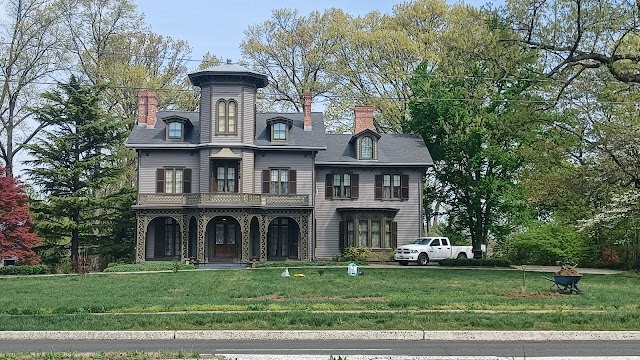


















































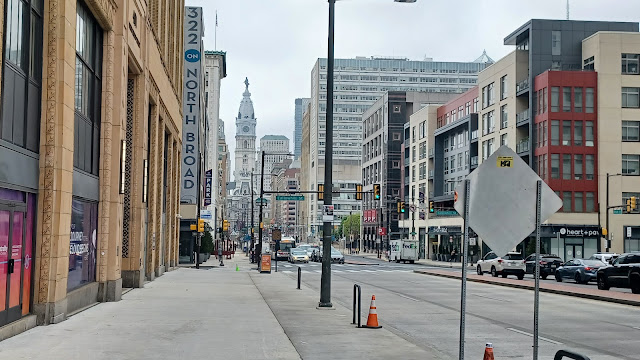



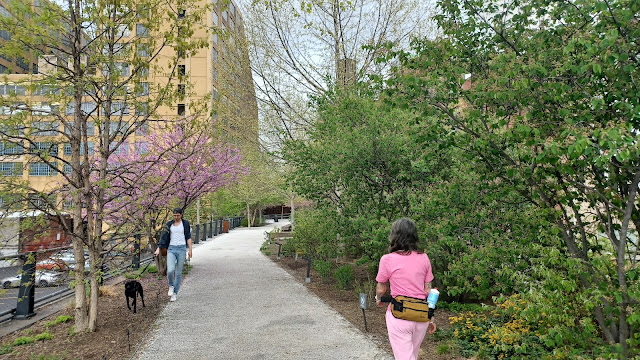













































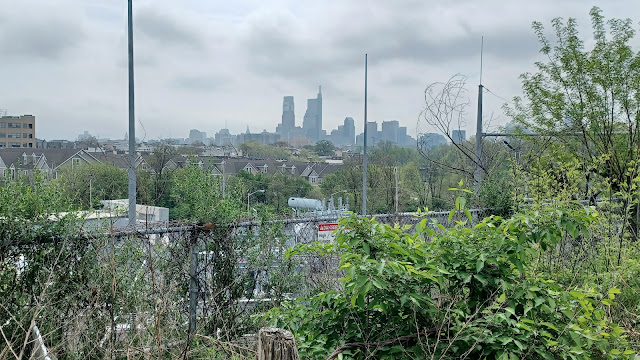


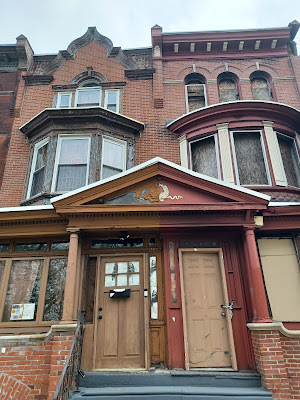


































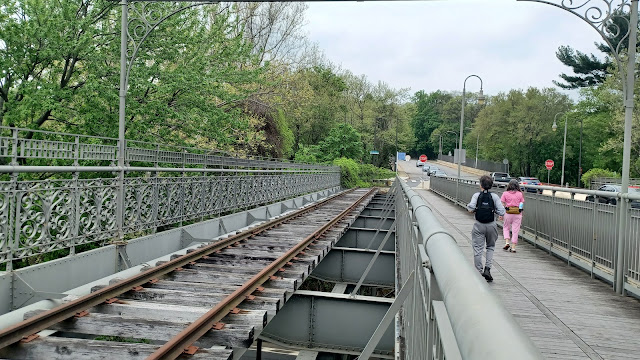













.jpg)






















